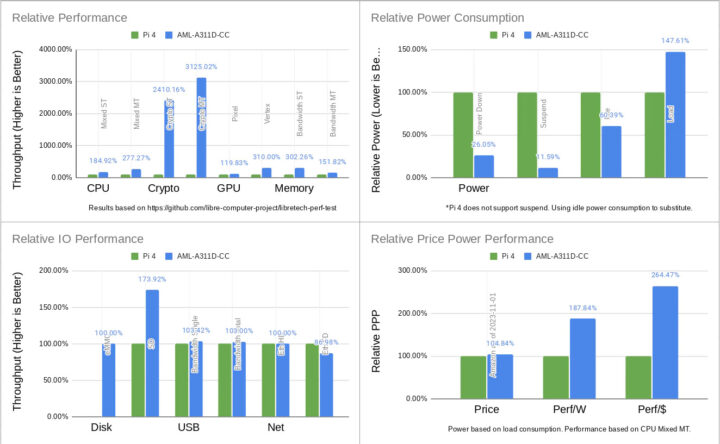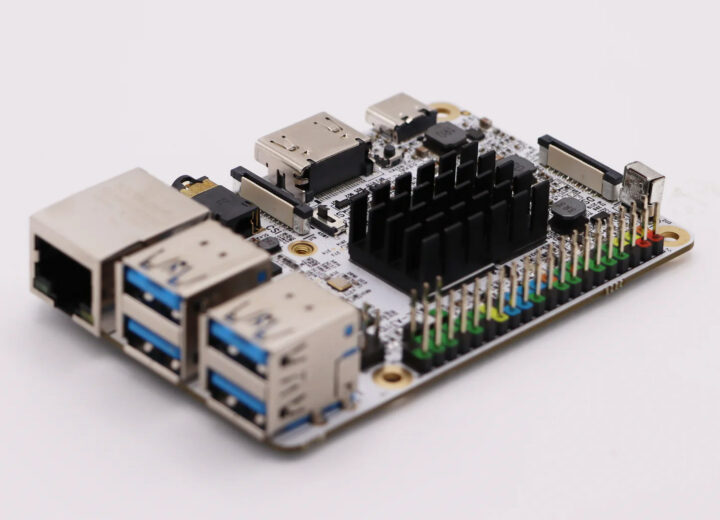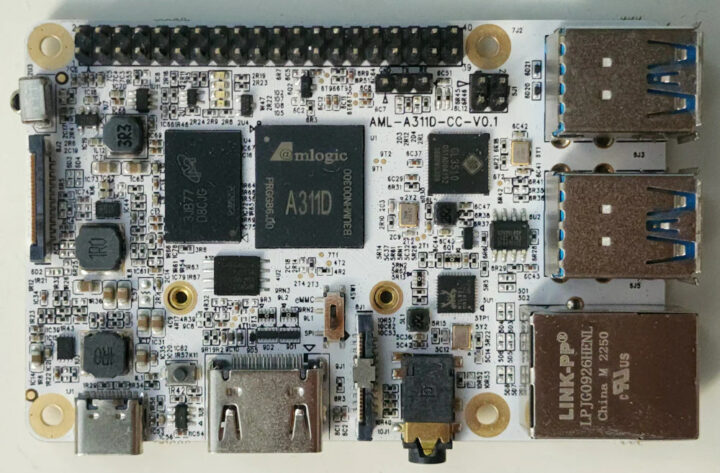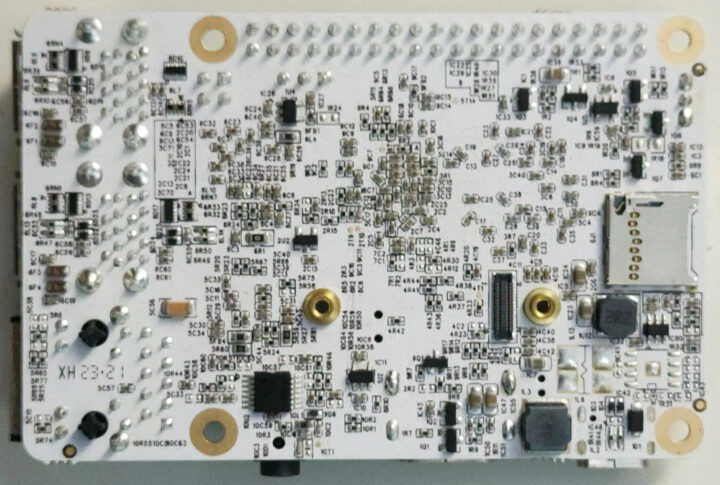Libre Computer has launched the credit card-sized “Alta” SBC, also known as AML-A311D-CC, designed for AI applications with the Amlogic A311D hexa-core Arm Cortex-A73/A53 processor equipped with a 5 TOPS AI accelerator.
The board comes with 4GB LPDDR4, a 16MB SPI flash for the bootloader as well as a microSD card slot and eMMC flash module connector for storage, and offers many of the same ports as found on the Raspberry Pi 3 Model B+ with Gigabit Ethernet, four USB 3.0 ports, HDMI output, an AV jack, MIPI CSI and DSI connector, and a 40-pin GPIO header that should work with most Raspberry Pi HATs.
AML-A311D-CC “Alta” specifications:
- SoC – Amlogic A311D
- CPU
- Hexa-core processor with 4x Arm Cortex-A73 cores @ up to 2.2 GHz and 2x Cortex A53 cores @ up to 1.8 GHz
- Built-in Cortex-M4 core for “always-on” processing
- GPU – Arm Mali-G52 MP4 GPU
- VPU
- 4K UHD H.265 75fps 10-bit video decoder & low latency 1080p H.265 / H.264 60fps decoder
- Supports multi-video decoding up to 4Kx2K@60fps + 1x1080P@60fps
- AI accelerator – 5.0 TOPS NPU @ 800 Mhz with support for Tensorflow, Caffe, and other deep-learning frameworks
- CPU
- System Memory – 4GB LPDDR4
- Storage
- 16MB SPI Nor flash for bootloader/firmware
- eMMC 5.x flash module connector
- MicroSD card slot with UHS SDR104
- Video & audio output
- HDMI 2.0 output
- 3.5mm AV jack for composite and stereo analog audio
- 4-lane MIPI DSI via 22-pin connector
- Camera – 4-lane MIPI CSI via 22-pin connector as found on the Raspberry Pi Zero W
- Connectivity – Gigabit Ethernet RJ45 port with optional PoE support
- USB – 4x USB 3.0 Type-A ports, 1x USB 2.0 OTG Type-C port with USB PD support
- Expansion – 40-pin GPIO header mostly compatible with the Raspberry Pi GPIO header
- Misc – IR receiver
- Power Supply
- 5V via USB-C port
- Power over Ethernet
- 5V via GPIO header
- Power Consumption – 1W idle power consumption (for reference my Raspberry Pi 5 was around 3W at idle with WiFi only)
- Dimensions – 85 x 56 mm
The Amlogic A311D was launched in 2019 and first found in the Khadas VIM3 SBC that we reviewed in both Android and Linux, and we also spent some time experimenting with the 5 TOPS NPU in Linux. So why bother launching a new SBC with a 4-year-old processor? That’s because Libre Computer has a different mission/business model and the company focuses on providing boards with as much upstream support as possible, and what really takes time is getting mainline Linux and other parts of the software to work on the hardware.
In practice that means the Ata SBC is compatible with Arm SystemReady IR operating system and incorporates a UEFI bootloader that can boot standard Linux distributions out of the box including any official Libre Computer images (Ubuntu, Debian, and Raspberry OS-based) or others such as Fedora and OpenSUSE. The company also mentions upstream AI and neuro-computing support, but I could not find any specific reference in the documentation, so I initially supposed they were just using the Rockchip RKNN-Toolkit2, but I eventually found a blog post about upstreaming the Teflon Delegate to the Mesa project. The documentation is all over the place and I find it a bit hard to navigate…

Libre Computer AML-A311D-CC “Alta” AI SBC is available for pre-order for $60 on LoverPi online store with deliveries starting on November 24. If you don’t need such as powerful SoC and an Amlogic S905D3 with a 1.2 TOPS NPU can do the job, you could alternatively pre-order the AML-S905D3-CC for $45 with the same form factor and software support. The company is also working on the AML-A311D-CM system-on-module mostly compatible with Raspberry Pi CM4 and that should be similar to the Banana Pi BPI-CM4 but with more recent software using the latest Linux kernel and scheduled for release on March 2024.
Thanks to Thomas for the tip.

Jean-Luc started CNX Software in 2010 as a part-time endeavor, before quitting his job as a software engineering manager, and starting to write daily news, and reviews full time later in 2011.
Support CNX Software! Donate via cryptocurrencies, become a Patron on Patreon, or purchase goods on Amazon or Aliexpress








We have been working on the software side for almost a year now. Lots of plumbing and tooling for a new platform bringup. This is not another A311D since it will have a lot of exclusive features for this and the CM to come.
And how should anybody know?
How should anybody know? Not sure what you mean.
Hi Da!
I think Thomas meant to say that you should probably be more verbose about all the great work you’re doing. The people here on this site as well as those (like me) who had the privilege to get these nice boards at Kernel Recipes 1.5 months ago know fairly well that your team is working relentlessly to deliver very slick products that work out of the box. But other companies brag a lot for much less work. I’m not for bragging, but maybe having a “news” page on the front of your site to regularly indicate what work is in progress or has been finished would attract more eyes on what you’re doing. For example this week-end I went to the site to see if the board was finally for sale, and didn’t find it in the products, though by searching in the forums I found an image (didn’t have the time to flash it yet). That’s definitely something to put upfront on the site: “News! new powerful hexacore Alta board for $60” with a link to the product page and some indications about what makes this one different from other A311D-based boards.
Just my two cents. In any case, keep up the great work!
Thanks. We’re heavily focused on scalability of processes and a lot of the work goes in the background completely invisible to end users. For example, our manufacturing testing processes and throughput are second to none. That’s how we can deliver multiple reliable mass market products and also why we take an conservative approach to releasing boards and making sure we do all the homework ahead of time. Upstream FOSS support is just one component of our work. We’re more of a software shop than a traditional SBC hardware shop. Throwing a bunch of components on a board is just one step in a hundred.
As for the media front, we realize we have not committed as much resource as we should. However, if you take a look at our historical product releases, every single one of our products is supported today running the latest software with constant improvements. That speaks for itself as other vendors either never support their hardware with proper software or barely supporting it for a year before they realize that the commitment is much bigger and costlier than they realized. We believe we can provide real value-add to the ecosystem through foundational work rather than a rat-race to the bottom.
Oh, rest assured I totally agree with your dedication to opensource, mainlining and so on. What I mean is that you know this, we know this, but a lot of the clueless people who just compare random boards found on amazon, aliexpress, and a few review sites have zero knowledge about all the hard work you’re doing silently. I’m pretty sure that lots of people will pick an RPi because they think it’s better supported (which is wrong). I can assure you that when I saw the A311D on the table at KR2023 with your brand on it, I thought “wow cool, now we have a fast *and* long-term supported board” (and promoted it to the people nearby), because I do know that this is what qualifies your products. But many people don’t.
I was waiting for the UEFI compatible firmware to appear on your site because even if I don’t like that much myself for PCs, I know that it eases linux installation and support on boards which otherwise don’t come with a cross-distro standard booting system, and I believe that once I can tell a few friends “buy this board and just insert a micro-SD with your favorite distro”, this can increase adoption.
But you should really put some news on your site about all this work. It’s not widely known and it’s a major differentiator compared to other vendors. It’s too bad customers are not aware of this before they choose a board.
Also, think about sending a couple boards to Jeff Geerling if you haven’t already. A review featuring the ease of installation could also have a positive impact on your sales 😉
Could you tell us about the positioning of the HDMI and 3.5mm AV ports?
Specifically, I would like to know whether they are in exactly the same alignment as found on the RPi3B+?
I.e. Do the HDMI and 3.5mm AV port components themselves have the same dimensions as they do on the RPi3B+?
Do they protrude from the edge of the Alta by the same amount as they do on the RPi3B+?
Is the centre of the HDMI port the same distance from the left hand edge of the Alta (the one with microSD port) as it is on the RPi3B+?
Likewise, is the 3.5mm AV port the same distance from that same left hand edge?
Excluding the USB-C port, can the Alta be used as a direct drop-in replacement for the RPi3B+?
Boards ending with -CC were all designed with consideration of our distributors and their accessory supply chains. All the boards stick to standards rigorously.
Thank you for replying!
In case it’s not obvious from my username, I’m specifically looking to use the Alta in a pi-top [3] laptop, as a replacement for the RPi3B+ around which it was designed.
I’ve already tried the Radxa Rock 3A which came very close but unfortunately the HDMI port protruded 2mm more beyond the edge of that SBC than it does on the RPi3B+ and thus I couldn’t use it in the pi-top as I was consequently unable to connect the thermal bridge to the hub.
There are 3D models of the several boards here: https://hub.libre.computer/t/libre-computer-board-3d-cad-models/ but I’m not sure if this one is there yet.
Thank you very much, Willy – I hope that will prove a very useful resource!
Also, completely agree that Libre Computer should be blowing their own trumpet a bit more!
Noted. We will fix this in future boards.
Damn that’s cool to hear, thanks Tom! Though don’t take my word for it and check the distance in-lab because I wouldn’t want to be responsible if it was 3mm rather than 2mm lol
For what it’s worth, Waveshare’s CM4 to RPi3B+ carrier/adapter board has the same size HDMI port in exactly the same alignment as on the RPi3B+ so I don’t know whether it’s possible to use exactly the same component or whether that would be a step backwards for the Rock 3A in terms of HDMI performance?
I am delighted to report that the HDMI and 3.5mm AV ports line up just fine with the pi-top [3]’s Hubv2!
Now I just need to know how to safely remove the pre-installed heatsink from the LC Alta and I’ll be able to connect the cooling bridge from the SBC’s GPIO pins to the Hubv2’s B2B connector.
Hello again Da Xue,
I’m glad that the Alta comes with a substantial heatsink pre-installed but, for my use case in particular, I was wondering how easy it is to remove that heatsink? (to be replaced by the cooling bridge of the pi-top [3] )
For the benefit of anyone else looking at doing the same, we now have the answer:
https://hub.libre.computer/t/libre-computer-aml-a311d-cc-alta-overview-and-resources/3014/5
What is the advantage of the A311 over the S922? Extra PCI-lanes? Expension possibilities in a later stage?
I did read the discussion on 8GB and I do agree the advantage of extra memory on old cores is limited.
If 1W can actually be achieved they really did something good since many boards with A55 cores struggle with low power.
The only benefit of A311D over S922 is the inclusion of the NPU. To be honest, 8GB on Cortex-X1 and below is overkill for most applications that these embedded SoCs target unless memory is all that matters for your application like Redis or Memcached or VMs. If you properly power gate the cores, you can drop power consumption to very low levels but it requires a lot of testing and software tuning.
> Question: is sbc-bench.sh opensource and available somewhere? Is it this one – https://github.com/ThomasKaiser/sbc-bench/blob/master/sbc-bench.sh ?
Yes
You can repost your comment there, and I’ll delete this one.
Yes, the link to sbc-bench.sh is correct.
FWIW I’ve flashed my A311D with the SPI firmware image found here: https://hub.libre.computer/t/libre-computer-board-firmware-update-images/3113
and it could boot and install an ubuntu server 22.04.3 image out of the box.
It’s quite pleasant to see a well-designed board providing SPI with a properly configured boot loader and DTB, it just works like a PC. Even the HDMI output is available under u-boot so you don’t really need a serial console. I wish other vendors would consider this option that significantly improves user experience. No need to switch to vendor-specific images nor complex boot procedures.
Well done, guys! Last time I had a similar experience was on the LX2K and the Ampere Altra dev kit, which are not exactly in the same price range 😉
We have spent years co-developing and upstreaming features in this boot stack along with the community. Our first production version was back in 2018. The time and money investment was not trivial.
I’m sure it was not trivial, but it was well spent, you can be proud of the resulting products! BTW, is there a reason the boards are still not listed on the products page on libre.computer ?
Is there any chance you might be able to run Fedora or GUIX SD on it?
I’m not going to test that today, but on the site fedora is said to be supported, and given that the board includes components that are supported upstream, I don’t see why it wouldn’t work.